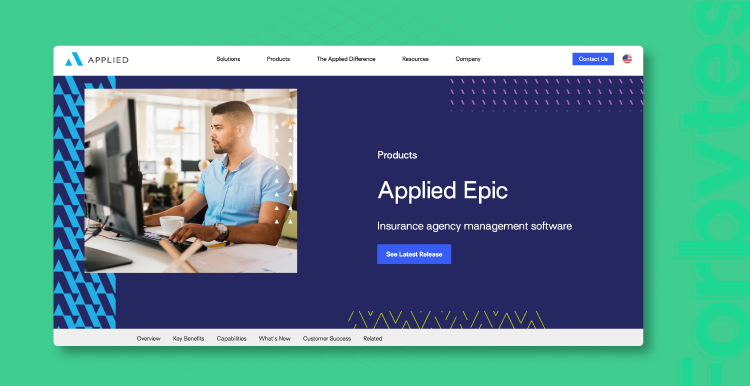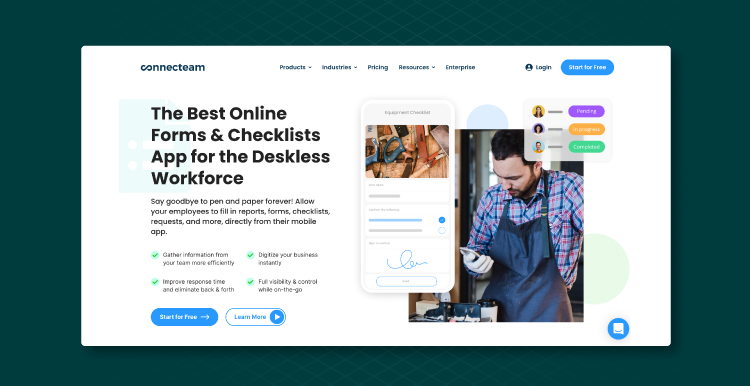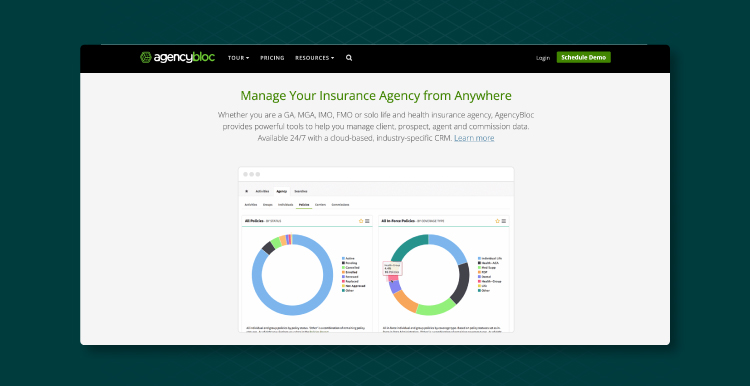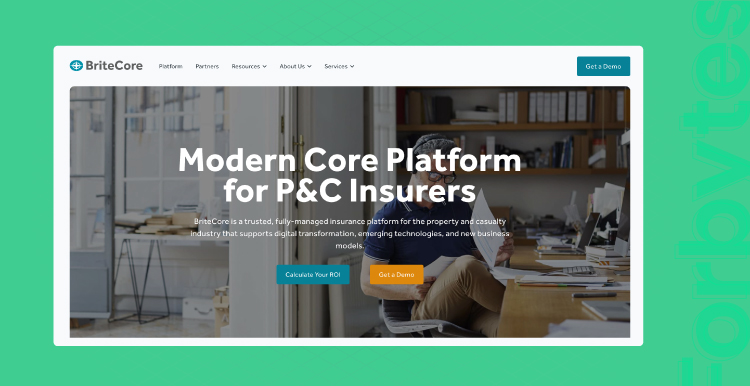The insurance industry somewhat lags behind when talking about the adoption of digital technologies by insurance agents. 63.3% of young agents state that the transformation is happening slowly. To manage all insurance processes “powered” by excessive amounts of paper documents manually, insurance agents need to be fully immersed in a cumbersome and time-consuming workload. And this, in turn, distracts agents from focusing on more business-oriented outcomes.
The outcomes of the tech-driven solutions for streamlining insurance operations are anticipated as the ones capable of delivering a 5-year revenue GAGR thanks to advanced analytics opportunities. This is four times higher in comparison with competitors. Let’s discover what agency management systems are and how they can be leveraged by insurance agents to manage vast amounts of data and combine them in a way that drives fast and efficient insights and data-driven business decisions.
What Are Insurance Agency Management Systems and How Can You Harness Them?
Insurance Agency Management Systems are geared to streamline insurance agents’ tasks via automation and data-driven tracking and control over the storage and organization of the workflow across the entire insurance value chain. With the management system, you can get instant access to your client’s data, track policies, and effectively manage and handle claims and commission procedures. Such a system is a centralized hub for data management. It facilitates capturing data from multiple data points and utilizing it holistically. Such an approach helps improve employees’ productivity while gaining new opportunities to attract solid leads.
Let’s outline briefly the main advantages of AMSs that can:
- Prevent siloed data that is scattered around;
- Automate repetitive processes;
- Streamline system procedures;
- Ensure the holistic access and view of all workflows;
- Enhance agent productivity;
- Ensure total control over insurance policy;
- Effectively manage customers’ claims;
- Retain customers and provide a highly positive experience.
According to the McKinsey report, there are many trends affecting insurers’ operating models due to the vulnerable tech-powered disruptions, such as changes in customer demands, tech adoption by well-known giants, and increased attention to technical debts. However, these changes will be fully adopted by insurance businesses in 2030. Today, there are already players that are gaining scale. Therefore, to stand out in the market, insurance companies have to adapt to an individual’s behavioral patterns and apply tailored usage-based insurance products. Extensive data ecosystems fueled by automation solutions and artificial intelligence can help insurers mature toward accelerating shifts.
Benefits and Features of Insurance AMSs
1. Personalization of customer experiences
According to the IBM report, 60% of executives in the insurance industry state that their CX strategy needs improvement. Therefore, following the customer-centric model can help insurers increase their conversion rates by strengthening their underwriting capabilities and digitizing their distribution platforms. To gain more advanced customer engagement and deliver greater experience, insurance businesses need to incorporate a new approach toward innovative value prepositions.

To foster sustainable growth, insurance agents must follow this innovative cross-cutting practice and develop effective communication strategies. AMS is fueled by extensive data retrieved from multiple touch points. It serves as a single location for tracking all the transactions with the clients, issuing policies, underwriting procedures, claims to process, and much more. Access to meaningful data is all in one place, allowing insurance agents to be equipped with historical data on customers’ purchases, requests, preferences, and other parameters.
For instance, with agency management systems, you can build personalized journeys and get a view of how your customer interacts with your products. With the feature of customer journey builder incorporated into AMS, you can set up various sales campaigns and appropriate goals (e.g. customer acquisition, cross-sell increase campaign, lead reactivation, etc.), detect problem areas, analyze customers’ behaviors, and adjust your strategy accordingly across communication channels.
2. Efficient policy tracking and management
With an insurance agency management system, you can keep a detailed track of policy information, the transactions of which are automatically downloaded into the system. Whether it is an individual or group policy management, you get the full coverage suit in one single location, enabling you to tie all the types and locate appropriate contact data with clients’ profiles.
With detailed graphs in the system, insurance agents can assess the status of policies, which keeps them updated on the renewal dates. Moreover, your clients are constantly updated on policy-specific shifts as well. In the system, you can create the history of each policy, covering the types, number, date of policy sale, carriers, and commissions. By setting up automated triggers, insurers notify clients of the date of their renewal.
Furthermore, calculating sales incentives can be overwhelming and can lead to inaccurate results. Automated commission processing is an advanced substitution of excel and spreadsheets that motivates agents to deliver greater outcomes and streamline the compensation administration procedures.
3. Enhanced lead and sales management
AMS is a great tool to nurture your lead base and maximize customer retention rates. Up-selling and cross-selling your products can be accelerated through scheduling sales activities with the consideration of such predetermined factors as time of renewal, policy issue date, its type, etc. Automated alerts are used to nurture your existing leads, qualify them before converting, and boost your customers’ lifetime value in the long run.
Moreover, the management system allows for the creation of a customizable lead form connected to the automated workflow. You do not need to enter all the details about a new lead manually, they will be transferred to the system automatically. Therefore, with AMS, insurance agents’ communication with leads, prospects, and customers is performed smoothly and at an advanced level since they are always connected to the system, which optimizes and streamlines interaction opportunities.
4. Increased agent productivity
Context switching has a negative impact on the employees’ productivity, affecting their focus, stress resistance, and workload, and hampering their efforts and mental health in general. According to Gerald Weinberg, productivity is killed up to 80% due to agents’ attention being scattered across different tasks and apps. Repeated interruptions may turn out to be beaten about the bush, which in the long run causes frustration and pressure in the working environment.
Indeed. In the study performed by the University of California and the Institute of Phylosogy, after only 20 minutes of interrupted performance, people at work experience high stress and workload. In order to overcome employees’ grievances and eliminate the mental load, business managers and owners must adhere to preferred interruption tolerance by incorporating customizable management systems. Such systems facilitate the consolidation of communication processes and workflows by giving access to users in a single centralized hub.
5. Advanced analytics and reporting
Tracking and analyzing reports in real-time will put your process of data evaluation and prediction on a higher level. With granular customer data, you can dive deeper into your business operational metrics represented in custom reports. Analytics incorporated into AMS fosters renewal business opportunities, helps identify the most profitable agents and keep track of success rates and progress. Let’s make an outline of the capabilities powered by in-depth analytics in management systems:
- Mitigating risks in the claims processes;
- Identifying customers at risk of cancellation;
- Controlling business efficiency level;
- Ensuring accuracy in policy, renewals, claims, and commissions accountability;
- Keeping track of agents’ working hours precisely;
- Forecasting cash flows and pipelines;
- Assessing insurer performance;
- Detecting pain points.
Top 5 Insurance Agency Management Systems
Applied Epic

This software allows for versatile solutions and opportunities across various insurance business touch points. In terms of internal processes, Applied Epic ensures instant access to the system where agents can check policy statuses, renewal dates, and other related details on the go and just in a few clicks. With the feature of omnichannel customer service, customers are seamlessly integrated with the online client and portal app where they can easily access their policy data. For P&C and benefit-focused sales groups, there is a solution to operate on a single source of truth – Applied Epic for Salesforce.
Features:
- 3D party integrations;
- Sales automation;
- Customer relationship management;
- Policy management;
- Document management;
- Integrated accounting.
Pricing: starts at $1,000 per license.
Connecteam

Connecteam is geared to streamlining workflows by digitizing and automating tasks through online forms, checklists, and reports. By storing all documents digitally, agents can conduct inspections and make any necessary entries from their smartphones. The user-friendly interface of the system allows agents to instantly track completion rates and share relevant entities with ease.
Features:
- Customizable forms, audits, and claims management;
- Image and video attachments;
- Audio messages recording;
- Customizable templates;
- Forms export;
- Real-time reports;
- Automated reminders and notifications;
- Timesheet and payroll management;
- In-app communication.
Pricing: a 14-day free trial. For the first 30 users, you get a free plan. Basic – $29/month, advanced – $49/month, expert – $99/month. There is the possibility of getting a free-for-life plan.
Vertafore AMS360

This system is highly configurable and easy-to-use, aimed at boosting customer retention rates and agency growth. Insurance agents are equipped with sophisticated capabilities to increase staff productivity and enhance customer experiences. With a complete view of clients’ information, insurers are able to quickly and effectively manage related documents. Furthermore, the eDocs automation feature allows managing carrier interactions without manually logging into carrier websites. Policy renewals are streamlined with automated alerts and enhanced with the capability to compare them automatically.
Features:
- TransactNow to consolidate carriers’ documents and messages in a single hub;
- Real-time customizable reporting;
- QuickNavs to effectively structure the workflows;
- Up-to-date real-time accounting;
- Seamless integration with other products (more than 500 APIs available);
- Document management and distribution;
- Proposal builder.
Pricing: No free trial. To find out pricing details, you need to contact their sales rep.
AgencyBloc

AgencyBloc is an all-in-one system that allows insurance companies to leverage industry-specific CRM systems to efficiently manage communication with prospects and clients as well as organize internal workflows inside the working environment. With workflow automation features, agents can optimize their processes and set up appropriate email marketing campaigns.
Features:
- Insurance CRM to keep track of clients and agents;
- Commissions processing according to carrier agreement;
- Workflow automation;
- Lead form builder;
- Marketing automation;
- Saved searches;
- Real-time reporting & dashboards;
- Prospecting & lead tracking.
Pricing: The plan starts at $70/month. It can be customized according to the agency’s requirements.
BriteCore

Powered by digital technologies and business intelligence analytics, BriteCore enables your clients to use an advanced approach toward operating their business. You can provide your customers and agents with customizable experiences by applying configurable agent portals or creating a customizable one. Being a cloud-based solution built on the AWS platform, BriteCore ensures instant connection and access to financial, claims, policy, and claims management documents. Moreover, with built-in APIs, the management system is partnered with more than 30 vendors. Therefore, you can easily rely on this system if your business scope needs to scale up and be integrated with other specific-industry applications.
With robust automation of policy renewals and the capability to pre-fill underwriting documents, BriteCore is geared at fitting the company’s preferred risk tolerance.
Features:
- Underwriting rule configuration tool;
- Product and document templates;
- Automated cloud deployments;
- Built-in APIs;
- Customer portal.
Pricing: No free trial. Contact a sales representative to find out the details.
Summing Up
Although the insurance industry is ripe to seize digital-powered solutions, its consumers still feel uncomfortable applying advanced technologies. Nevertheless, the technological transformation is imminent and the Insurance Agency Management System market is forecasted to reach $4835.5 million in 2028.
Besides managing the book of business and streamlining insurance internal processes, management systems empower agents to be more productive and deliver high-level and innovative experiences to their customers. This results in high customer retention rates as well as high revenue growth.
If you are looking for an efficient solution that will enhance your ROI and will justify itself, contact our team. We will provide you with dedicated experts tailored to your specific business requirements.

Our Engineers
Can Help
Are you ready to discover all benefits of running a business in the digital era?

Our Engineers
Can Help
Are you ready to discover all benefits of running a business in the digital era?







